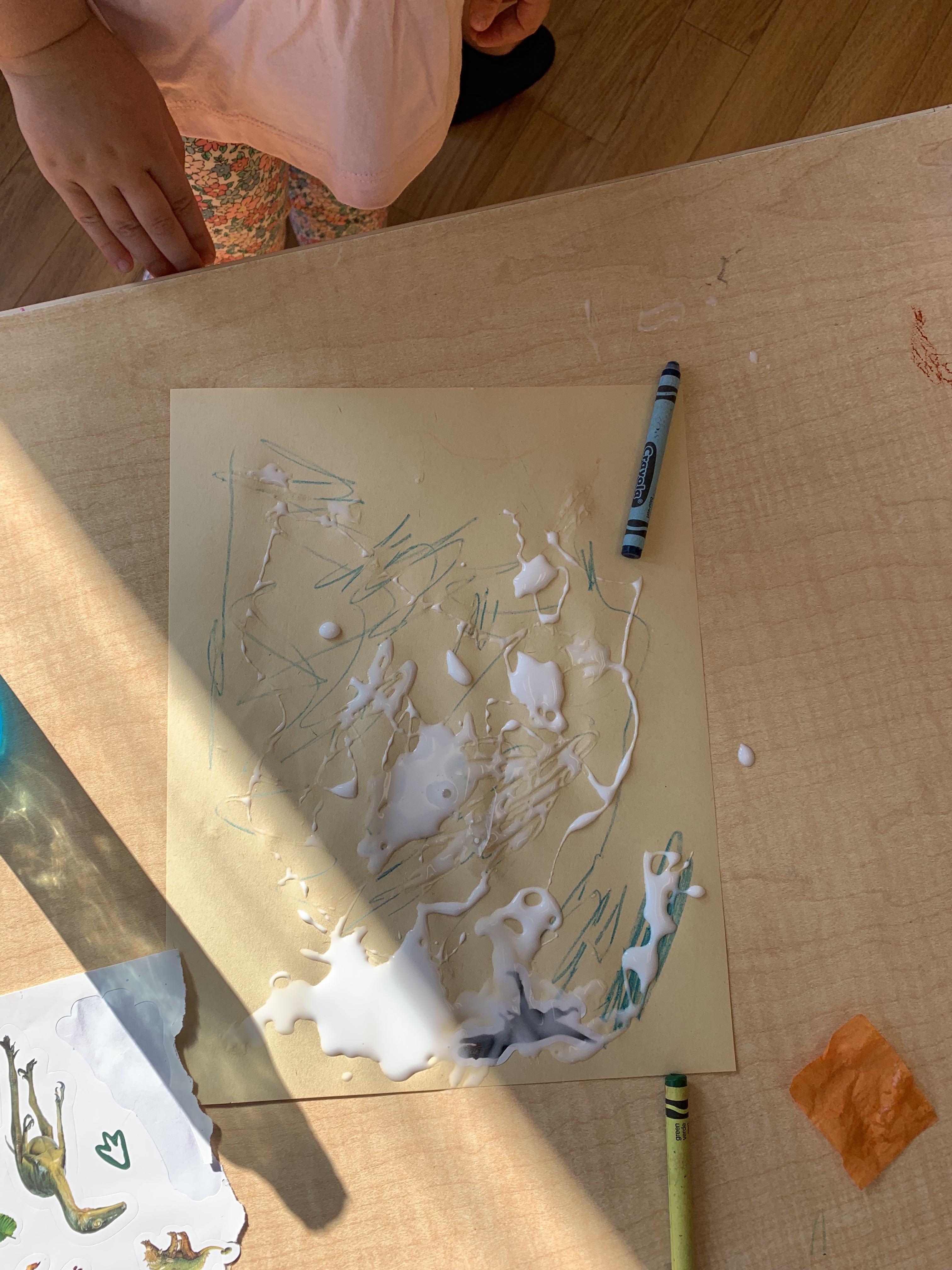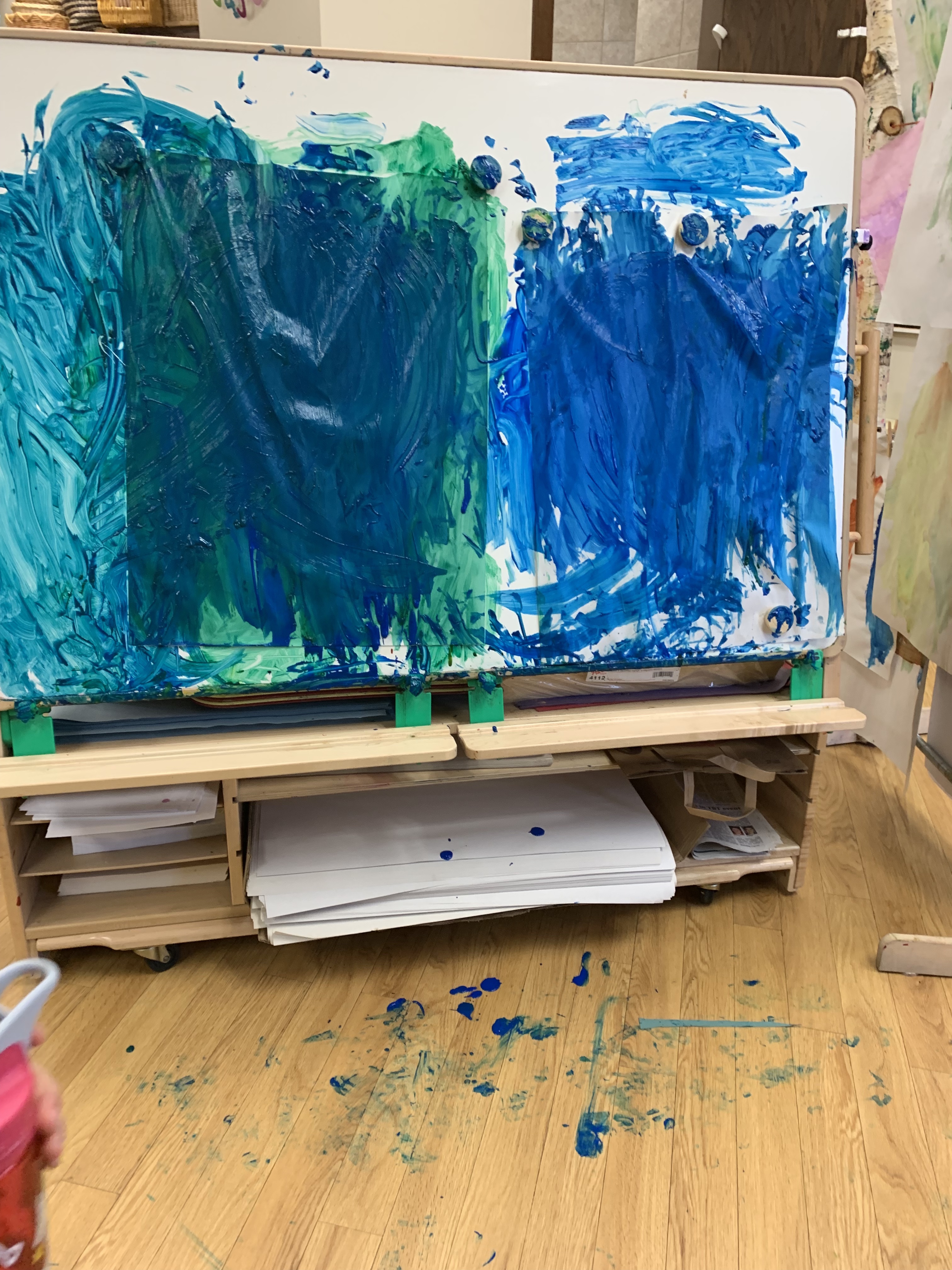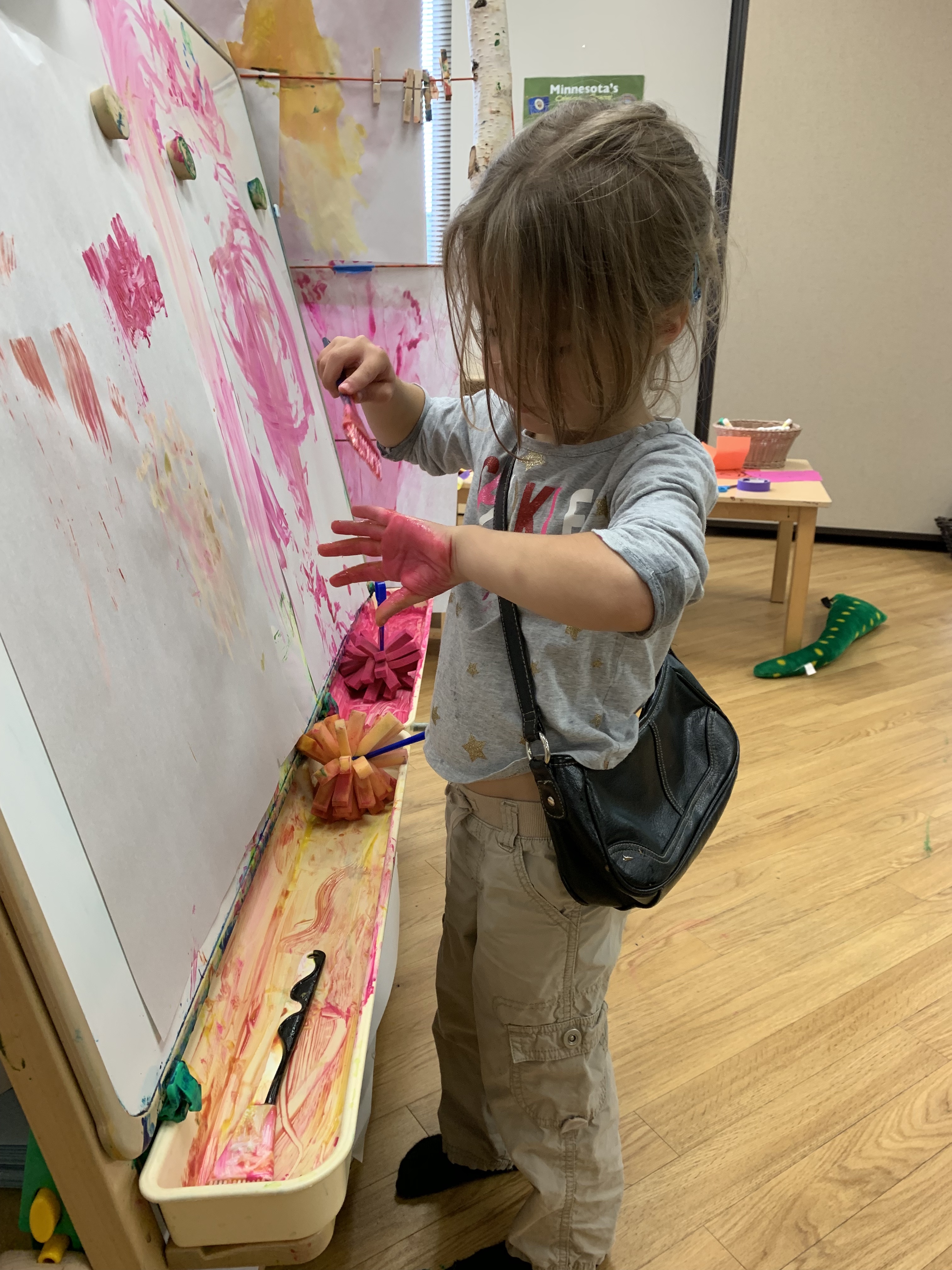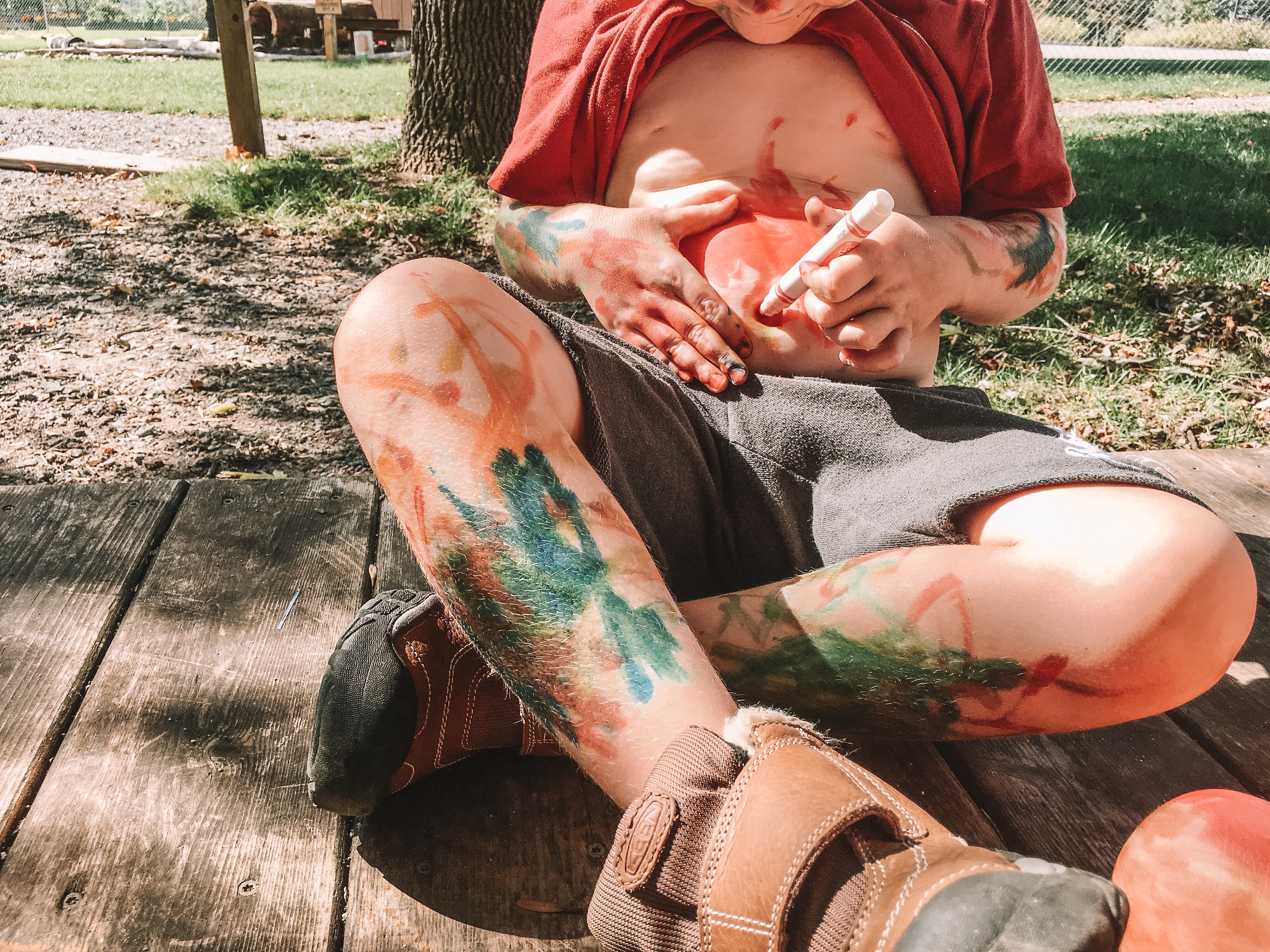I Don't Allow Craft Time In My Preschool Classroom
Nov 02, 2021
I loathe crafts in the preschool classroom. Like, LOAAATTTHHE, in my best grinch voice. What do I prefer? Process art. Read on to find out what I mean by 'process art', the reason why this is my preferred method in my early childhood environment and how you can easily implement process art in your own program!
One of my favorite memories in the classroom is when a child spent 10 minutes squeezing a bottle of white elmer's glue out onto a paper plate. They squeezed with their fingers, their palms and they even ended up putting the bottle between their chin and their chest to help aid in the squeezing when their hands got tired. They filled the WHOLE plate with glue.
I watched from afar as the whole process unfolded and wondered what they were thinking and what their plan was. After about 9 minutes another child that was standing there saw them struggling and told them they could take the cap off and the glue would come out faster. They did it and they were able to get the last of the glue out in one big squeeze. They put the glue bottle down, stood back and admired it with their hands on their hips, looked around at the table top, looked down at the floor, saw a pony bead on the floor, picked it up and carefully placed it in the giant paper platey puddle of glue - right in the smack dab center.
They looked around, caught my eye and said, “I’m done”. I asked, “What is your plan for this project?” They said, “Take it home for my mom.” OK! I offered to help carry it to the drying rack. When the end of they day came, they went to the drying rack and, of course, it wasn’t dry in the least bit. I told them that sometimes big puddles of glue take a while to dry and we could check in on it tomorrow. The next day came and the glue was still wet. We watched that glue dry. Literally. For about a week.
Finally, the next Monday, we returned to school and instead of a glue lake, it was a smooth and shiny surface that was semi-transparent like ice. The child learned so much through that process. They learned more doing this type of project than they ever would have learned had they been sitting at a table following the steps to creating a 17 part teddy bear with brads to make the arms moveable.

Speaking of a 17 part teddy bear with brads to make the arms moveable, I did this. Before I knew better, I was a teacher directed craft expert. I LOVED searching for the cutest crafts for preschoolers on pinterest and planning my classroom themes to match. I spent hours on the weekends cutting out certain parts of the bear to make the process doable for the children. “Art” was planned into the centers we had for each day and a teacher sat at the table for all art projects to aid the children or really just tell them what to do. I would walk the children step-by-step through each part of the process and thought I was teaching them valuable skills like waiting, and cutting, and listening and direction following.
But, now I realize, all I was teaching them was that I was in control and that I had the best ideas for how things should look, and that art was all the same for all the children. I stole their creativity. I stole time from them. I stole their intrinsic motivation. Art wasn’t art. And that teddy bear project, it was a WEEK long of the step by step process to put those 17 parts together. And I had to do most of the work. Sure, some kids LOVED it. Others hated it and let me know that by getting frustrated.
What is the difference between process art vs. product based art? It is just as it sounds… process art is creating a thing for the process of creating the thing.Many times there isn’t an absolute end goal with young children. They start and then just keep adding or subtracting until their little heart says it is time to be done. They cover a whole chair with a purple glue stick, they paint a picture at the easel and then take one color and cover up the whole entire picture with a solid color, they find an empty gallon from milk and fill it with glue, put a whole bunch of bead inside the milk jug, shove a piece of paper in the mouth of the jug and then call it a day. (We had this project hanging from our preschool’s ceiling for 3 years).
I want to go over the characteristics of creative freedom and process art in the classroom, but first I want to explain why I think creative freedom is important in the early childhood environment.
Let’s chat about NASA. I promise it will make sense in a minute. NASA is one of the USA’s space programs that has been around for many years. NASA needs people who have the ability to think divergently - meaning they can think fast to come up with creative and innovative ideas or ways to do things. Because when you are in space and things take a wrong turn, you have to be able to think quickly with creative solutions to solve problems!
NASA hired a scientist by the name of Geroge Land to create a test that could measure an adult’s capacity for divergent thinking. He came up with the test and it worked so well, but only 2% of adults could pass this test. George and His college Beth Jarman decided to give the test to a group of 4 and 5 year olds just to see what their level of divergent thinking was. They gave the test to 1600 children. 98% passed! 98%!! They were floored by these results so they decided they should do a longitudinal study. They gave the same test to the same kids fiver years later when they were 10. 30% passed. Another 5 years and 12% could pass at 15. As adults, only 2% could pass.
So what was the conclusion? The conclusion is that our ability to think creatively and divergently is born into us and then gets unlearned over time. Schools and the way we are brought up in the world suck the creativity right out of us. So, we need to do our part to ensure that young children have the time to create freely, exercising their own minds in their own way, to dream up new ideas and new solutions to problems they are having and be supported in this along the way! When we have time to dream and imagine things, we get amazing ideas. When we give children time to play and freedom to explore materials in their own way, we are supporting their divergent thinking! Not being a creative vampire sucking teacher.

In a time of rapidly changing technologies, we need to raise up children who can think creatively and we can do this by scrapping the teacher directed crafts and offering an environment that supports creation of things and ideas instead!
Watch George Land explain the study here: TEDxTucson George Land The Failure Of Success
Now that I told you why it is important, I want to talk about the characteristics of process art and creative freedom. This is probably not going to be an exhaustive list, but a few things to get your brain thinking. I have to explain in terms of what process art IS NOT in order for us to understand what process art IS! I really don't enjoy making lists that are all negative in nature but I think it is important to point it out this way to have a better grasp on it. And remember, we are all learning and we all start somewhere, so if there are characteristics of NOT ART that I explain that are happening in your environment, don’t get all worried! The journey to a play based environment is a learning process and it takes time. Maybe just commit to changing one thing this week to get your classroom on the way to creative freedom!
Here we go:
- Process art does not involve the adult in the environment AT ALL. Unless you are asked to join them. But even then you want to leave the control and creative process up to the child. If they ask you to do all the work, they probably haven’t flexed their creative freedom enough in their life to know what it feels like to enter the creative flow state! They need to practice. So no matter how much they plead for your help, it is important to allow them the time and space to figure things out on their own. They may not be able to do a thing they way they anticipate, but they may learn even more with trial and error than they would if you take over and do the thing for them. Let them flex those creative muscles!
 2. Process art doesn’t always look like art. We adults have a picture in mind of what we think an art project looks like. But creative freedom doesn’t always happen in the art area of the classroom! The definition of art is: the expression or application of human creative skill and imagination, typically in a visual form such as painting or sculpture, producing works to be appreciated primarily for their beauty or emotional power. Art can look like a really cool block tower. Art can look like a song that is being made up or a new outfit made from scraps of fabric for a doll in the classroom. Art can look like drawing with washable markers on arms. Art can look like placing sticks into rows or patterns outdoors on the grass. Art can look like hammering puzzle pieces onto a piece of wood or making a pattern with nails on a pumpkin.
2. Process art doesn’t always look like art. We adults have a picture in mind of what we think an art project looks like. But creative freedom doesn’t always happen in the art area of the classroom! The definition of art is: the expression or application of human creative skill and imagination, typically in a visual form such as painting or sculpture, producing works to be appreciated primarily for their beauty or emotional power. Art can look like a really cool block tower. Art can look like a song that is being made up or a new outfit made from scraps of fabric for a doll in the classroom. Art can look like drawing with washable markers on arms. Art can look like placing sticks into rows or patterns outdoors on the grass. Art can look like hammering puzzle pieces onto a piece of wood or making a pattern with nails on a pumpkin.
 3. Process art involves intrinsic motivation. Accordion to the APA Dictionary of Psychology, The definition of intrinsic motivation is : an incentive to engage in a specific activity that derives from pleasure in the activity itself (e.g., a genuine interest in a subject studied) rather than because of any external benefits that might be obtained (e.g., money, course credits) So this means that the child has to choose it. The child has to be in control of the art they are creating. Wether it be a song, dance, painting, game, make believe world, or a typical ‘project’ that is created at the art tables with glue and stickers and markers and crayons, it must be driven by the child.
3. Process art involves intrinsic motivation. Accordion to the APA Dictionary of Psychology, The definition of intrinsic motivation is : an incentive to engage in a specific activity that derives from pleasure in the activity itself (e.g., a genuine interest in a subject studied) rather than because of any external benefits that might be obtained (e.g., money, course credits) So this means that the child has to choose it. The child has to be in control of the art they are creating. Wether it be a song, dance, painting, game, make believe world, or a typical ‘project’ that is created at the art tables with glue and stickers and markers and crayons, it must be driven by the child.
 4. Process art does not include craft examples from a teacher. It can be so tempting to place one of your teacher-created crafts out on the table, or leave a teacher-created painting near the easel so they can get ‘ideas’ about what to create, but that will limit the creative flex we need to give children in our play-based environments. We can’t control what will happen when they get to Kindergarten, but we can control the environment we provide for them when they are in preschool. Knowing that creativity will be unlearned in the future, we need to give them ALL THE POSSIBLE TIME WE CAN to create freely in our play based environments.
4. Process art does not include craft examples from a teacher. It can be so tempting to place one of your teacher-created crafts out on the table, or leave a teacher-created painting near the easel so they can get ‘ideas’ about what to create, but that will limit the creative flex we need to give children in our play-based environments. We can’t control what will happen when they get to Kindergarten, but we can control the environment we provide for them when they are in preschool. Knowing that creativity will be unlearned in the future, we need to give them ALL THE POSSIBLE TIME WE CAN to create freely in our play based environments.
Things to provide in your play based learning environment to support creative freedom and process based learning…
Open ended materials all over the classroom. These tend to be things that the early childhood industry calls ‘loose parts’. Loose parts are things that don’t have a particular use and can be used in many different ways depending on the child’s needs and imagination. There are a gazillion loose parts ideas out there - do a google search and you will come up with thousands of ideas.
- Bottle caps, puzzle pieces, scraps of paper, cardboard, toilet paper tubes, wood pieces, tree cookies, tissue paper, pom poms, beads, string or yarn
- These along with the traditional ‘art’ materials we allow children the creative freedom to make what feels good to them! Traditional materials include tape, markers, crayons, colored pencils, glue, paint, etc.
- In other areas of the room we have wood blocks, large tree cookies, leather scraps, fabric pieces, wood napkin rings, large amounts of the same type of cup, battery operated tea light candles, clamps, clothespins.
So there you have it. Let’s give children a childhood that supports their creative thinking muscles instead of hindering them. Give them time and space to create as they see fit. And enjoy watching the process unfold!

Title of Your Awesome Resource
Lorem ipsum dolor sit amet, metus at rhoncus dapibus, habitasse vitae cubilia odio sed.






